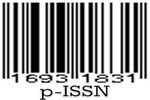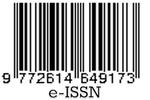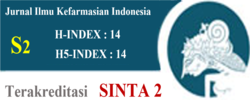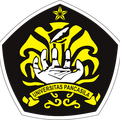Stabilisation Potential of Cell Membrane from Different Polarity Extract of Sirih Bumi (Peperomia pellucida [L.] Kunth) as Anti-inflammatory Agent
Abstract
Sirih bumi (Peperomia pellucida [L.] Kunth.) is a medicinal herb. Anti-inflammatory activities are reported. These plant extracts have been shown to reduce inflammation in many studies, but it is unknown which extract works best. The objectives if this study were determine the extract that has the best anti-inflammatory activity from sirih bumi. The activity was assessed from the impact of stabilising red blood cell membranes in vitro. The research was then continued with a literature study on the chemical compounds containing the best extracts. To determine the prediction of the compound responsible for its activity and potency, several in silico tests were carried out, such as PASS online, Pre-ADMET online, and Protox II. The test results showed that the ethyl acetate extract at 200 g/mL concentration showed similar activity to aspirin at the same concentration. The activity of this extract increased with increasing concentration of the extract. Six compounds were reported to be isolated from this type of extract. Dillapiol and its derivative 6-allyl-5-methoxy-1,3-benzodioxol-4-ol are predicted to be compounds that have anti-inflammatory effects by inhibiting the membrane permeability mechanism of ethyl acetate extract. Ethyl acetate extract showed the best anti-inflammatory activity among the other type of extract from sirih bumi. Ethyl acetate extract is a type of extract with the best anti-inflammatory activity from sirih bumi.
References
2. Katzung BG. Farmakologi dasar dan klinik. Jakarta: EGC; 2010.
3. Kartika IGAA, Insanu M, Safitri D, Putri CA, Adnyana IK. New update: traditional uses, phytochemical, pharmacological and toxicity review of Pp (l.) Kunth. Pharmacol Online. 2016(2):30–43.
4. Kartika IGAA, Bang IJ, Riani C, Insanu M, Kwak JH, Chung KH, et al. Isolation and characterization of phenylpropanoid and lignan compounds from Pp [L.] Kunth with Estrogenic Activities. Molecules. 2020;25(21):4914.
5. Kartika A, Riani C, Insanu M, Paiboonsukwong K, Charoenphandhu N, Tubsuwan A, et al. Potent inhibition of Pp extracts towards rankl-induced osteoclast formation through m1 macrophage polarization. Rasayan J Chem. 2021;14:1369–77.
6. Kartika IGAA, Insanu M, Riani C, Kyu HC, Adnyana IK. Polarity difference and the presence of phytoestrogen compounds affecting estrogenic activity of Pp extracts. Sains Malays. 2021;50(2):449–60.
7. Kartika IGAA, Riani C, Insanu M, Eljabbar LFD, Ad¬nyana IK. Sasaladaan (Pp [L.] Kunth.) extracts improve trabecular bone microarchitecture in ovariectomy-induced osteoporotic rats. Int J Green Pharm IJGP. 2018;12(04):S1–6.
8. Kartika IGAA, Riani C, Insanu M, Adnyana IK. Pp extracts stimulates bone healing in alveolar socket following tooth extraction. J Tradit Complement Med. 2022;12(3):302–7.
9. de Fátima Arrigoni-Blank M, Dmitrieva EG, Franzotti EM, Antoniolli AR, Andrade MR, Marchioro M. Anti-inflammatory and analgesic activity of Pp (L.) HBK (Piperaceae). J Ethnopharmacol. 2004;91(2–3):215–8.
10. Arrigoni-Blank M de F, Oliveira RLB, Mendes SS, Silva P de A, Antoniolli AR, Vilar JC, et al. Seed germination, phenology, and antiedematogenic activity of Pp (L.) H. B. K. BMC Pharmacol. 2002;2:1-8.
11. Wijaya SWM. Uji efek antiinflamasi ekstrak herba suruhan (Pp L. Kunth) pada tikus putih jantan. Berkala Penelitian Hayati. 2004;9:115–8.
12. Mutee AF, Salhimi SM, Yam MF, Lim CP, Abdullah GZ, Ameer OZ, et al. In vivo anti-inflammatory and in vitro antioxidant activities of Pp. International Journal of Pharmacology. 2010;6(5):686–90.
13. Salim E, Kumolosasi E, Jantan I. Inhibitory effect of selected medicinal plants on the release of pro-inflammatory cytokines in lipopolysaccharide-stimulated human peripheral blood mononuclear cells. J Nat Med. 2014;68(3):647–53.
14. Anosike CA, Obidoa O, Ezeanyika LU. Membrane stabilization as a mechanism of the anti-inflammatory activity of methanol extract of garden egg (Solanum aethiopicum). DARU J Pharm Sci. 2012;20(1):76.
15. Gadamsetty G, Maru S. Antioxidant and anti-inflammatory activities of the methanolic leaf extract of traditionally used medicinal plant Mimusops elengi L. J Pharm Sci. 2013;6:125-30.
16. Lagunin A, Stepanchikova A, Filimonov D, Po¬roikov V. PASS: prediction of activity spectra for biologically active substances. Bioinforma Oxf Engl. 2000;16(8):747–8.
17. Kartika IGAA, Sinarsih NK, Nayaka NMDMW. Anti-inflammatory activities of Pp [L.] Kunth.: A Review. J Pharm Sci Appl. 2022;4(1):39–44.
18. Nasution PR, Zulfikri Z. Uji efektivitas ekstrak etanol daun suruhan (Pp) sebagai antiinflamasi. Sains Med. 2023;1(5):298–306.
19. Kumar NS. Evaluation of rbc membrane stabilization and antioxidant activity of Bombax ceiba in an in vitro method. Int J Pharma Bio Sci. 2011;2:220-6.
20. Chippada S chaitanya, Volluri SS, Bammidi SR, Vangalapati M. In vitro anti inflammatory activity of meth¬anolic extract of Centella asiatica by HRBC membrane stabilisation. Rasayan J.Chem. 2011;4(2):457-60.
21. Vane JR, Botting RM. The mechanism of action of aspirin. Thromb Res. 2003;110(5–6):255–8.
22. Fujiati F, Haryati H, Joharman J, Utami SW. In vitro metabolite profiling and anti-inflammatory activities of Rhodomyrtus Tomentosa with red blood cell membrane stabilization methods. Rep Biochem Mol Biol. 2022;11(3):502–10.
23. Kartika IGAA, Insanu M, Riani C, Chung KH, Ad¬nyana IK. Polarity difference and the presence of phytoestrogen compounds affecting estrogenic activity of Pp extracts. Sains Malays. 2021;50(2):449-460.
24. Manivannana R, Sukumar D. The RBC membrane stablisation in an in vitro method by the drug isolated from Leucas aspera. International Journal of Applied Science and Engineering. 2007;5(2):133-38.
25. Maulia A, Safitri A, Fadly A, Ismail I. Antiinflammatory activity test of cocor bebek leaves (Kalanchoe pinnata L) against rats feet (Rattus novergicus). J Ilmu Kefarmasian Indonesia. 2020;18:164–8.
26. Maleki SJ, Crespo JF, Cabanillas B. Anti-inflammatory effects of flavonoids. Food Chem. 2019;299:125124.
27. Al-Khayri JM, Sahana GR, Nagella P, Joseph BV, Alessa FM, Al-Mssallem MQ. Flavonoids as potential anti-inflammatory molecules: a review. Molecules. 2022;27(9):2901.
28. Wan H, Huang X, Xu Y, Liu M, Wang J, Xiao M, et al. Threshold effects and inflection points of flavonoid intake in dietary anti-inflammatory effects: Evidence from the NHANES. Medicine. 2023;102(36):e34665.
29. Gajender U, Mazumder A, Sharma A, Azad MAK. A Comprehensive review of the pharmacological importance of dietary flavonoids as hepatoprotective agents. Evid Based Complement Alternat Med. 2023; p e4139117.
30. Hämäläinen M, Nieminen R, Vuorela P, Heinonen M, Moilanen E. Anti-inflammatory effects of flavonoids: genistein, kaempferol, quercetin, and daidzein inhibit STAT-1 and NF-kB Activation along with their inhibitory effect on iNOS expression and no production in activated macrophages. Mediators of Inflammation. 2007;2007:1-10.
31. Hartati S, Angelina M, Dewiyanti I, Meilawati L. Isolation and characterization compounds from hexane and ethyl acetate fractions of Pp L. J Trop Life Sci. 2015;5(3):117–22.
32. Parise-Filho R, Pastrello M, Pereira Camerlingo CE, Silva GJ, Agostinho LA, de Souza T, et al. The anti-inflammatory activity of dillapiole and some semisynthetic analogues. Pharm Biol. 2011;49(11):1173–9.
33. Bonam SR, Wang F, Muller S. Lysosomes as a therapeutic target. Nat Rev Drug Discov. 2019;18(12):923–48.
34. Kartika IGAA, Sinarsih NK, Nayaka NMDMW. Anti-inflammatory activities of Pp [l.] kunth.: a review. Journal of Pharmaceutical Science and Application. 2022;4(1):39-44.
35. Ng ZX, Than MJY, Yong PH. Pp (L.) Kunth herbal tea: Effect of fermentation and drying methods on the con-sumer acceptance, antioxidant and anti-inflammatory activities. Food Chem. 2021;344:128738.
36. Lipinski CA. Lead- and drug-like compounds: the rule-of-five revolution. Drug Discov Today Technol 2004;1(4):337–41.

This work is licensed under a Creative Commons Attribution-NonCommercial-ShareAlike 4.0 International License.
Licencing
All articles in Jurnal Ilmu Kefarmasian Indonesia are an open-access article, distributed under the terms of the Creative Commons Attribution-NonCommercial-ShareAlike 4.0 International License which permits unrestricted non-commercial used, distribution and reproduction in any medium.
This licence applies to Author(s) and Public Reader means that the users mays :
- SHARE:
copy and redistribute the article in any medium or format - ADAPT:
remix, transform, and build upon the article (eg.: to produce a new research work and, possibly, a new publication) - ALIKE:
If you remix, transform, or build upon the article, you must distribute your contributions under the same license as the original. - NO ADDITIONAL RESTRICTIONS:
You may not apply legal terms or technological measures that legally restrict others from doing anything the license permits.
It does however mean that when you use it you must:
- ATTRIBUTION: You must give appropriate credit to both the Author(s) and the journal, provide a link to the license, and indicate if changes were made. You may do so in any reasonable manner, but not in any way that suggests the licensor endorses you or your use.
You may not:
- NONCOMMERCIAL: You may not use the article for commercial purposes.
This work is licensed under a Creative Commons Attribution-NonCommercial-ShareAlike 4.0 International License.





 Tools
Tools





















